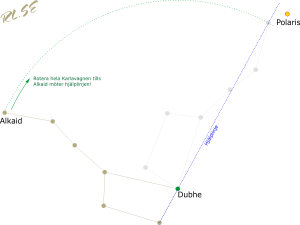The North Star or Pole Star, is famous for holding nearly still in our sky while the entire northern sky moves around it. That’s because it’s located nearly at the north celestial pole, the point around which the entire northern sky turns. Polaris marks the way due north. As you face Polaris and stretch your arms sideways, your right hand points to the east, and your left hand points to the west. About-face of Polaris steers you to the south.
Polaris is also famous for marking the end of the Little Dipper‘s (Ursa minor) handle. The Little Dipper is tougher to spot in the night sky than the Big Dipper. But if you use the Big Dipper’s (Ursa Major) pointer stars to locate Polaris, you’ll be one step closer to seeing the Little Dipper.
In the Sami stories the Northern Star is called Boahjenástir. It is located in the middle of the northern sky. Earlier people envisioned the sky as a roof-like dome that had to be held upright and unmoving by a world column. In this dome, the North Star was a fixed point around which all other stars endlessly circled.
Earlier there existed a great fear among the Sami that the world would fall apart. This fear still exists, in different ways. This is one of the reason why Sami people used to offer a male reindeer to the North Star in Autumn. The sacrifice maintains the balance, keeping the world pillar from falling. If the pillar falls down, all the sky will fall down. And this would be the end of the known world.




